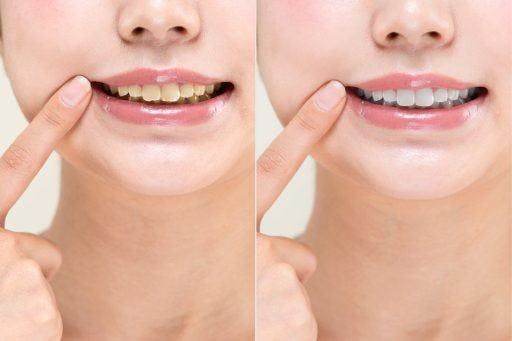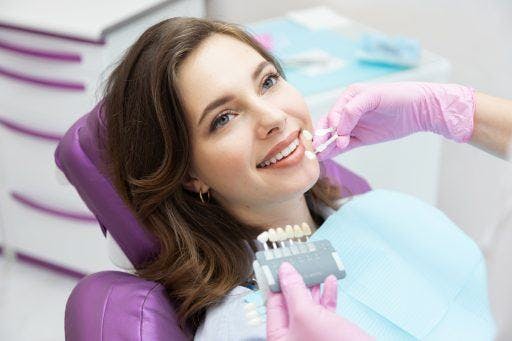Spoiler alert! Most of the time, stained teeth are more of a cosmetic issue. However, it can also signify deeper oral issues and may prompt non-dental concerns, such as poor self-esteem.
Learn all about stained teeth – why discolouration happens, when you should do something about it, and how you can make your pearly whites glisten again.
What are stained teeth?
Stained teeth refer to teeth that have lost their natural color due to various factors. This discolouration is primarily a cosmetic issue but can significantly impact a person’s confidence.
What are the types of tooth stains?

Have you noticed a yellow tinge on your teeth? You may rush to have them whitened but keep in mind there are different kinds of stained teeth. It’s good to know which category you fall under before you seek a solution. There are generally two types of tooth stains:
Extrinsic stains
These stains occur on the surface enamel or the tooth exterior. Enamel is what comes into contact with the things you consume, such as food and drinks. Over time, the effects of your diet can build up on your enamel, creating a stain. Porous teeth and thinning enamel can also increase the likelihood of these stains.
Intrinsic stains
Intrinsic stains happen on the dentin or the layer underneath the enamel. Culprits are typically from excess fluoride consumption, which can create brownish staining or mottling, or tooth decay, which starts greyish or black. Other causes include medication and nerve damage.
Primary causes of stained teeth
No one ever gets stained teeth instantly. It’s usually the culmination of habits and perhaps irregular dental hygiene.
You love coffee, tea, or red wine.
Do you love drinking coffee, tea, or red wine – maybe all three of them? One of the most common causes of teeth discolouration is the consumption of certain foods and beverages. These can stain teeth due to their high levels of chromogens or the pigments that can stick to tooth enamel. Dark-coloured fruits and vegetables such as blueberries and beets can also cause staining.
Meanwhile, acidic foods and drinks such as citric fruits can cause tooth enamel to wear away, making teeth appear yellow as the underlying dentin becomes more visible.
You practise poor dental hygiene.
It should go without saying, but poor dental hygiene can lead to stained or yellow teeth. Without brushing and flossing regularly, plaque can build up on the surface of the teeth, which appears yellow or discoloured. Over time, plaque can lead to cavities, which show up as dark spots on the teeth.
You’re a regular smoker.
Smoking and tobacco use are also common causes of yellow teeth. Nicotine and tar from cigarettes can penetrate tooth enamel, causing discolouration that can be difficult to remove. In addition, smoking can also contribute to gum disease and other oral health problems.
But what about vaping? “Flavoured liquids and nicotine used in vapes often include colouring agents that can contribute to a yellow or brown appearance of teeth,” notes The University of Queensland.
Your medication or medical condition could be the culprit.
Certain medications can also cause stained or discoloured teeth. Some drugs, like antihistamines, antipsychotics, and high blood pressure medications, can also lead to tooth discolouration. Other medical treatments, such as chemotherapy and radiation treatment, might also affect your teeth.
Meanwhile, some medical conditions also contribute to stained or yellow teeth. Diseases that affect enamel formation, such as amelogenesis imperfecta and dentinogenesis imperfecta, can cause teeth to be discoloured. In addition, certain conditions, such as celiac disease and gastroesophageal reflux disease (GERD), can cause enamel erosion, leading to yellowing or staining.
What the colour of your teeth stain means
The colour of your teeth stain can also reveal its underlying cause, notes the International Journal of Health and Clinical Research. Here are possible factors:
- Yellow: Often linked to dietary habits (such as coffee, tea, or certain foods), smoking, certain medications, or dry mouth.
- Brown: Typically associated with smoking, untreated cavities, or tartar buildup.
- White: Indicates potential overexposure to fluoride or early signs of cavities.
- Gray: Suggests the presence of a dead nerve, often due to dental trauma or decay inside the tooth.
- Purple: Commonly caused by consumption of red wine or foods with strong pigments.
- Black: Indicates severe decay or the presence of black tartar.
How to whiten stained teeth

How to get rid of stained teeth? Follow these strategies:
Practise excellent oral hygiene habits.
The first step is to exercise good oral hygiene. Brushing and flossing frequently can help remove plaque and prevent cavities, which can lead to discoloured teeth.
Try expert-recommended treatments.
You can also up your routine with whitening toothpaste or mouthwash to brighten your smile. Or, you could also try at-home whitening treatments. However, make sure to consult a dental professional before try any of these options.
Visit your dentist.
For more serious stains, drop by your dentist. They may scrape off oral biofilm and tartar that contribute to your smile’s yellowish hue. They can also make assessments of your dental condition, such as crookedness or overlaps that make teeth harder to clean, making you more prone to plaque and, consequently, stains and discolouration.
So, apart from performing professional whitening or bleaching treatments that work faster and more effectively than DIY methods, they might also recommend other orthodontic treatments, such as aligners, like ClearCorrect, to help you achieve optimum dental health. You can wear these aligners while whitening your teeth, allowing you to hit two birds with one stone.
Take this online smile assessment to know if you’re a candidate for clear aligners.
Make lifestyle changes.
Try limiting your teeth-staining activities, such as drinking and smoking. You could also drink with a straw to prevent contact with teeth.
Can stained teeth ever be white again? Of course! But first, you need to identify their cause. Follow the tips above, brush your teeth properly, and visit your dentist regularly if you want to enjoy a brilliant white smile.
References:
Kansal, S., Jindal, L. J., Garg, K., & Pachori, H. (2020). Discoloration of Teeth: A Literature review. International Journal of Health and Clinical Research.
Watts, A., & Addy, M. (2001). Tooth discolouration and staining: a review of the literature. British Dental Journal, 190(6), 309–316.



